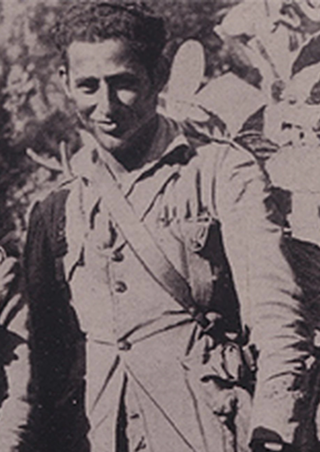
Gandesa is the capital of the comarca of Terra Alta, in the province of Tarragona, Catalonia, Spain.

Terra Alta is a sparsely populated inland comarca (county) in Terres de l'Ebre, Catalonia (Spain). Its capital is Gandesa. It is also known as Castellania, a name dating back to its medieval status as a fiefdom held by the Order of Knights of the Hospital of St. John of Jerusalem under the Crown of Aragon.

The Battle of the Ebro was the longest and largest battle of the Spanish Civil War and the greatest, in terms of manpower, logistics and material ever fought on Spanish soil. It took place between July and November 1938, with fighting mainly concentrated in two areas on the lower course of the Ebro River, the Terra Alta comarca of Catalonia, and the Auts area close to Fayón (Faió) in the lower Matarranya, Eastern Lower Aragon. These sparsely populated areas saw the largest array of armies in the war. The battle was disastrous for the Second Spanish Republic, with tens of thousands left dead or wounded and little effect on the advance of the Nationalists.

Mohammed ben Mizzian was a Moroccan senior military officer and prominent military figure in Francoist Spain and Morocco.

"¡Ay Carmela!" is one of the most famous songs of the Spanish Republican troops during the Spanish Civil War.

El Pinell de Brai is a municipality in the comarca of la Terra Alta in Catalonia, Spain.

Serra de Pàndols is a limestone mountain chain located at the southern end of the Catalan Pre-Coastal Range, in Catalonia, Spain.

Serra de Cavalls is a mountain chain located at the southern end of the Catalan Pre-Coastal Range, Catalonia, Spain. The ridge's highest point is Punta Redona. This mountain range lies within the Benissanet, Gandesa and El Pinell de Brai municipal term. On the northern side are two ridges of parallel foothills called Serra del Pebre and Serra de Santa Madrona. Its northern prolongation is known as Serra de la Vall de la Torre.
The Battle of Gandesa took place in April 1938 during the Spanish Civil War.

"Si me quieres escribir", also known as "Ya sabes mi paradero" and "El frente de Gandesa", is one of the most famous songs of the Spanish Republican troops during the Spanish Civil War. According to Emilia Salas Viú, widow of Rodolfo Halffter, the author of the lyrics was Emilio Prados.

The 224th Mixed Brigade was a mixed brigade of the Spanish Republican Army in the Spanish Civil War. It was formed in summer 1937 in Catalonia from scattered Coastal Defence units and had four battalions: the 893, 894, 895 and 896.

The 227th Mixed Brigade, was a mixed brigade of the Spanish Republican Army in the Spanish Civil War. It was formed in the spring of 1938 in Catalonia and had four battalions, the 905, 906, 907 and 908.

The 226th Mixed Brigade, was a mixed brigade of the Spanish Republican Army in the Spanish Civil War. Part of its forces had belonged to the former Bautista Garcet Battalion, which had distinguished itself in the combats of the Córdoba offensive at the beginning of the Civil War. Its formation began in August 1937 in Catalonia, but it was delayed for a long time, the brigade not becoming fully operational until 1938. It had four battalions, the 901, 902, 903 and 904.

The 11th Division was a division of the Spanish Republican Army in the Spanish Civil War. It was formed in January 1937 in Madrid beginning with the 1st Mixed Brigade which in turn had originated in the Fifth Regiment.

Serra de la Vall de la Torre, also known as Serra de la Vall, is a mountain range located at the southern end of the Catalan Pre-Coastal Range, Catalonia, Spain. The ridge's highest point is 450.8 m. This mountain range lies within the Benissanet and Corbera d'Ebre municipal term. It is a smaller and lower northern prolongation of the Serra de Cavalls.

The 35th Division was a division of the Spanish Republican Army in the Spanish Civil War.

The 42nd Division was a division of the Spanish Republican Army in the Spanish Civil War.
The 59th Mixed Brigade was a unit of the Spanish Republican Army created during the Spanish Civil War. It came to operate on the Teruel and Ebro fronts.
The 16th Division was one of the divisions of the Spanish Republican Army that were organized during the Spanish Civil War on the basis of the Mixed Brigades. It had an outstanding participation in the Battle of the Ebro.
The XII Army Corps was a military formation belonging to the Spanish Republican Army that fought during the Spanish Civil War. Formed by veteran units, throughout the war it took part in prominent intervention in some of the main battles of the war, such as Aragon or the Ebro.












